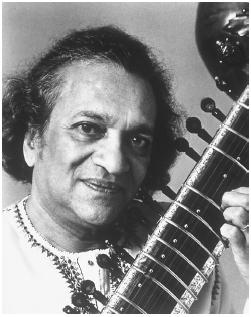Ravi Shankar - Writer
Composer. Nationality: Indian. Born: Benares, 7 April 1920. Education: Attended a French Catholic school, Paris, 1930–32; studied Kathak and Kathakali styles of classical Indian dance, Calcutta. Family: Married Annapurna Akbar, children: one son. Career: Musician and dancer with Uday Shankar Company of Hindu Dancers and Musicians in Paris, early 1930s, composer and performer on the sitar from 1939; 1945—first film as composer, Dharti Ke Lal ;

Films as Composer:
- 1945
-
Dharti Ke Lal (Abbas); Neecha Nagar (Anand)
- 1955
-
Pather Panchali ( Father Panchali ) (S. Ray)
- 1956
-
Aparajito ( The Unvanquished ) (S. Ray); Chairy Tale
- 1957
-
Parash Pathar (Ray); En djungelsaga ( The Flute and the Arrow ) (Sucksdorff)
- 1959
-
Apur Sansar ( The World of Apu ) (S. Ray)
- 1960
-
Anuradha (Mukherjee)
- 1961
-
Kabuliwala (Sinha); Megh (U. Dutt)
- 1962
-
Godan
- 1964
-
Ghum Bhangaar Gaan (U. Dutt)
- 1965
-
Chappaqua (Rooks)
- 1968
-
Charly (Nelson)
- 1972
-
Alice's Adventures in Wonderland (Miller)
- 1977
-
Mira (Gulzar)
- 1982
-
Gandhi (Attenborough)
- 1986
-
Génésis (Sen)
Publications
By SHANKAR: books—
My Music, My Life , New York, 1968.
Sri Sri Ravi Shankar: The Way of Grace , Fairfield, 1996.
By SHANKAR: article—
Montage , July 1966.
On SHANKAR: article—
Current Biography 1968 , New York, 1968.
* * *
Although Ravi Shankar composed small pieces on the sitar (a seven-stringed Indian instrument which he has made worldfamous) as background scores for some commercial Hindi films, and composed complete scores for two offbeat Hindi films in the mid-1940s, he did not come to be known as a film composer until Satyajit Ray's Pather Panchali made a world sensation in 1955. Shankar composed the music after seeing only a few sequences at the request of Ray, a family friend, and recorded it in one session of 11 hours.
Although Shankar is a profound practitioner of Indian classical music on many types of instruments, his style is more fluid and innovative than most great Indian sitarists, such as Ustad Bilayet Khan who composed the score of Ray's musical film Jalsaghar . This is evident from his soul-stirring scores for the Apu trilogy, Gandhi , and Anuradha . In Pather Panchali , which remains his best film score, the sequence of the improvident father's return home with a sari for the dead daughter and the mother's breakdown in tears would not have been half as moving if it were not enhanced by a little-known string instrument, tar sanai . Similarly, the pathos of the sequence of Gandhi's offer of a cloth to an ill-clad woman bathing in Ganges would not have been so cathartic if accompanied by a rigid classical raga on any other instrument.
Shankar never took his film scores too seriously; they were mostly concessions to friends and admirers. Nor are his scores dramatic or cinematic enough to bring home a situation or a dialogue in a lighter vein. He is too sublime to condescend to "ridiculous" moments in a film, one of the reasons Ray did not use him beyond the Apu trilogy. Nevertheless, the fluidity of his style and improvisations had a free play on the soundtrack of the trilogy. According to him, Indian classical music can convey the entire gamut of human emotions and feelings in films if it is played with an admixture of folk music, "or each by itself." "It is wrong to say that Indian classical music cannot convey emotion." He is himself pleased with his scores for the trilogy and for two of Utpal Dutt's films. The "pure gold" in Ravi Shankar which, according to Yehudi Menuhin, drew American youth to him, also shone in his film scores, because in these casual playful pieces "there was a synthesis of the immediacy of expression, the spontaneity, truth, and integrity of action suited to the moment that is a form of honesty characteristic of both the innocent child and the great artist."
—Bibekananda Ray
Comment about this article, ask questions, or add new information about this topic: